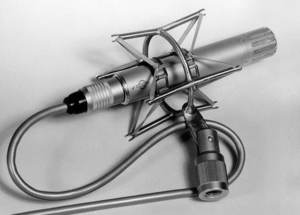- in Gear , Microphones by Bobby Owsinski
5 Condenser Microphone Fallacies That Will Make You Think Differently About Them
 Condenser microphones are fraught with fallacies that often lead to misuse and poor results thanks to unreasonable expectations. This excerpt from the 4th edition of my Recording Engineer’s Handbook looks at 5 popular misconceptions about condenser microphones, along with why the real reason might not be what you think.
Condenser microphones are fraught with fallacies that often lead to misuse and poor results thanks to unreasonable expectations. This excerpt from the 4th edition of my Recording Engineer’s Handbook looks at 5 popular misconceptions about condenser microphones, along with why the real reason might not be what you think.
1. A large-diaphragm condenser has more low end than a small-diaphragm condenser. This is not necessarily true. In many cases, small-diaphragm condensers reproduce the low end just as well as their larger kin.
2. A cardioid condenser has a better low-end response than an omni. Not true. In condenser mics with an omnidirectional polar response, the bass response is only limited by the electronics. Even a very small-diaphragm mic can have a flat response down to below 20 Hz.
3. A large-diaphragm condenser has a flatter response than a small-diaphragm condenser. Not true. Large-format capsules are prone to low-frequency resonance, which means that they can have trouble reproducing low frequencies at a high level. They can also “bottom out” as a result of the diaphragm hitting the backplate, which is the popping that can occur when a singer is too close to an unfiltered microphone. To minimize this, some microphones over-damp the capsule, making the mic sound either thin or alternatively lumpy in response, while some address this by adding a low-frequency roll-off or EQ circuitry to try to put back frequencies suppressed in the capsule.
4. A small-diaphragm condenser is quieter than a large-diaphragm. Not true. The difference in the size of the diaphragm translates into a difference in signal-to-noise ratio. The bigger diaphragm provides more signal for a certain electrical noise level and therefore can be quieter than the small diaphragm.
5. Condenser mics have a consistent response from mic to mic. They’re not as close as you might think. Despite what the specs might say, there can be vast differences in the sound between two mics of the same model, especially in the less expensive versions. This particularly applies to tube-type mics, where there are not only differences between the capsules, but also matching of the tubes, and is usually the result of not enough attention being paid to small details during design and manufacture.
Unless two mics are specifically matched in their frequency response, differences between them are inevitable. That said, the value of precise matching of microphones is open to much debate. One school of thought says that you need closely matched response for a more precise stereo soundfield, while another school thinks that the difference can actually enhance the soundfield.
Condenser microphones are wonderful tools, but as with everything else in your audio toolbox, they must be matched to the task for best results. Hopefully clearing up these 5 misconceptions will ensure a better result the next time you need to use one.
You can read more from The Recording Engineer’s Handbook and my other books on the excerpt section of bobbyowsinski.com.
